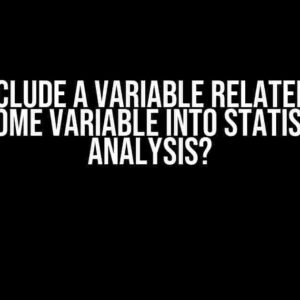Are you puzzled by the mysterious sign flip of eigenvectors when dealing with small covariance changes? You’re not alone! Many data scientists and machine learning enthusiasts have stumbled upon this phenomenon, only to be left wondering what’s going on. In this article, we’ll delve into the world of eigenvectors, covariance matrices, and dimensionality reduction to uncover the reasons behind this curious behavior.
What Are Eigenvectors and Covariance Matrices?
Before we dive into the meat of the matter, let’s quickly review some essential concepts.
Eigenvectors and Eigenvalues
Eigenvectors are non-zero vectors that, when transformed by a linear transformation, result in a scaled version of the same vector. In other words, they’re vectors that, when transformed, retain their direction but change their magnitude. The scaling factor is called an eigenvalue.
Ax = λx
where A is the linear transformation, x is the eigenvector, and λ is the eigenvalue.
Covariance Matrices
A covariance matrix is a square matrix that summarizes the covariance between different features in a dataset. The covariance between two features is a measure of how they change together. The covariance matrix is typically denoted as Σ (sigma) and is calculated as follows:
Σ = E[(X - μ)(X - μ)^T]
where X is the dataset, μ is the mean, and E is the expected value.
In the context of dimensionality reduction, we’re interested in the eigenvectors and eigenvalues of the covariance matrix. The eigenvectors of the covariance matrix represent the directions of maximum variability in the data, while the corresponding eigenvalues represent the magnitude of that variability.
The Sign Flip Phenomenon
Now that we’ve covered the basics, let’s get back to our original question: why does the sign of an eigenvector flip for small covariance changes?
The answer lies in the way eigenvectors are calculated. When we compute the eigenvectors of a covariance matrix, we’re finding the directions that explain the most variance in the data. However, these directions are not unique and can be scaled by a negative factor without changing the variance they explain.
Example 1: A Simple 2D Case
Consider a 2D dataset with two features, x and y. The covariance matrix is:
| 1.0 | 0.8 |
| 0.8 | 1.0 |
The eigenvectors of this matrix are:
eigenvector 1: [0.707, 0.707]
eigenvector 2: [0.707, -0.707]
Now, let’s introduce a small covariance change by adding 0.1 to the top-right element of the covariance matrix:
| 1.0 | 0.9 |
| 0.9 | 1.0 |
Surprisingly, the eigenvectors flip their signs!
eigenvector 1: [0.707, -0.707]
eigenvector 2: [0.707, 0.707]
This seems counterintuitive, but it’s a direct result of the non-uniqueness of eigenvectors. The direction of maximum variance hasn’t changed, but the eigenvectors have flipped signs to accommodate the small covariance change.
Why Does the Sign Flip Happen?
There are several reasons why the sign flip occurs:
- Non-uniqueness of eigenvectors**: As mentioned earlier, eigenvectors are not unique and can be scaled by a negative factor without changing the variance they explain. This means that the eigenvectors can flip signs without affecting the underlying data.
- Numerical instability**: When computing eigenvectors, numerical methods can introduce small errors that cause the signs to flip. This is particularly true when dealing with small covariance changes.
- Randomness in the data**: In real-world datasets, there’s often some degree of randomness or noise. This randomness can cause the eigenvectors to flip signs, especially when the covariance changes are small.
How to Avoid the Sign Flip
While the sign flip phenomenon can be frustrating, there are ways to avoid or mitigate its effects:
- Standardize your data**: Standardizing your data can help reduce the impact of small covariance changes on the eigenvectors.
- Use a consistent eigenvector calculation method**: Ensure that you’re using a consistent method for calculating eigenvectors, such as the power iteration algorithm or the QR algorithm.
- Regularize your covariance matrix**: Adding a small regularization term to the covariance matrix can help stabilize the eigenvectors and reduce the likelihood of sign flips.
- Monitor eigenvector stability**: Keep an eye on the stability of your eigenvectors across different iterations or covariance changes. If you notice a sign flip, re-run the calculation with a different initial guess or method.
Conclusion
The sign flip phenomenon is a common occurrence in dimensionality reduction and eigenvector analysis. While it may seem counterintuitive, it’s a direct result of the non-uniqueness of eigenvectors and the numerical instability of eigenvector calculations. By understanding the underlying causes and taking steps to mitigate its effects, you can ensure that your dimensionality reduction techniques provide accurate and reliable results.
So, the next time you encounter a sign flip, don’t panic! Instead, take a deep breath, review your covariance matrix, and remember that it’s just a small bump in the road to data insights and wisdom.
Frequently Asked Question
Get ready to uncover the mysteries of eigenvectors and covariance matrices! We’ve got the scoop on why those pesky signs of eigenvectors flip for small covariance changes.
What’s the deal with eigenvectors and their signs flipping?
Eigenvectors are not unique and can be scaled by any non-zero value, including -1. This means that an eigenvector and its negative have the same direction, but opposite signs. When the covariance matrix changes slightly, the eigenvector computation might converge to the opposite sign, causing the flip.
Is it only the sign that flips, or does the entire eigenvector change?
When the sign of an eigenvector flips, the entire eigenvector doesn’t change; only its direction is mirrored. The eigenvector’s magnitude and orientation remain the same, but its direction is now opposite.
Why do small changes in covariance cause such a drastic effect on eigenvectors?
Small changes in covariance can significantly impact the eigenvector computation because the eigenvalue decomposition is sensitive to even tiny perturbations in the matrix. This sensitivity can cause the eigenvector to “jump” to its opposite sign, especially when the eigenvalues are close or degenerate.
Can I avoid this sign flip issue altogether?
While it’s not possible to completely eliminate the sign flip issue, you can mitigate it by using techniques like eigenvector normalization, ensuring the covariance matrix is well-conditioned, or using algorithms that are less sensitive to sign changes, such as PCA with a symmetric matrix.
What’s the takeaway from all this eigenvector sign flipping business?
The key is to understand that eigenvectors are not unique and can flip signs due to small changes in covariance. By acknowledging this, you can take steps to minimize its impact and make informed decisions when working with eigenvectors and covariance matrices.


